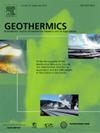The evidence of H-O-C isotopes in response to earthquake and the precursor anomaly index: A case study of geothermal fluids in the Xianshuihe fault
IF 3.9
2区 工程技术
Q3 ENERGY & FUELS
引用次数: 0
Abstract
Earthquake forecasting remains challenging due to the limited understanding of reliable precursory signals. While hydrochemical anomalies in geothermal fluids prior to seismic events show promise, the response mechanism of H-O-C isotopes (δD, δ18O, δ13C) during seismogenesis and their quantitative links to tectonic processes are poorly constrained. We conducted continuous hydrogeochemical monitoring and stable isotope mass spectrometry (δD, δ18O, δ13CDIC) on geothermal fluids in the seismically active Xianshuihe fault zone (Western Sichuan, China). Time-series data from two hot springs (LTGS and EDQP) during the 2022∼2023 aftershock sequence of the Ms6.8 Luding earthquake were statistically analyzed using a Z-score method to quantify precursor anomalies. (1) Pre-seismic δD and δ18O exhibited rise-fall trends, driven by fracture-enhanced fluid mixing and water-rock interaction. δD anomalies were uniquely sensitive to earthquakes Ms ≥ 5.5. (2) Elevated δ13C originated from thermal decomposition of deep carbonate during tectonic stress accumulation, releasing 13C-enriched CO2. Subsequent dissolution and isotopic exchange impart this high-δ13C signature to dissolved inorganic carbon (DIC); (3) A Z-score ≥ 2 effectively discriminated precursor anomalies for Ms > 4.0 earthquakes, with precursor response times of 10 days to 2 months. This study establishes H-O-C isotopes as dynamic indicators of seismogenic processes and proposes a Z-score method for short-imminent earthquake forecasting. Integrating these indicators into multi-parameter monitoring networks, contributing to the development of multi-parameter seismic monitoring in active fault zones.
H-O-C同位素对地震的响应证据及前兆异常指数——以鲜水河断裂地热流体为例
由于对可靠的前兆信号的理解有限,地震预报仍然具有挑战性。虽然地震前地热流体的水化学异常有希望,但H-O-C同位素(δD、δ18O、δ13C)在地震发生过程中的响应机制及其与构造过程的定量联系尚不清楚。对地震活跃的川西鲜水河断裂带地热流体进行了连续水文地球化学监测和稳定同位素质谱分析(δD、δ18O、δ13CDIC)。利用Z-score方法对泸定6.8级地震余震序列中LTGS和EDQP两个温泉的时间序列数据进行了统计分析。(1)地震前δD和δ18O呈上升-下降趋势,主要受裂缝增强的流体混合和水岩相互作用的驱动。δD异常对Ms≥5.5的地震特别敏感。(2)构造应力聚集过程中深部碳酸盐岩热分解导致δ13C升高,释放出富含13c的CO2。随后的溶解和同位素交换使溶解的无机碳(DIC)具有高δ 13c特征;(3) z分数≥2能有效判别4.0级地震前兆异常,前兆响应时间为10天~ 2个月。本文建立了H-O-C同位素作为孕震过程的动态指标,提出了短临地震预报的z分数方法。将这些指标整合到多参数监测网络中,促进了活动断裂带多参数地震监测的发展。
本文章由计算机程序翻译,如有差异,请以英文原文为准。
求助全文
约1分钟内获得全文
求助全文
来源期刊

Geothermics
工程技术-地球科学综合
CiteScore
7.70
自引率
15.40%
发文量
237
审稿时长
4.5 months
期刊介绍:
Geothermics is an international journal devoted to the research and development of geothermal energy. The International Board of Editors of Geothermics, which comprises specialists in the various aspects of geothermal resources, exploration and development, guarantees the balanced, comprehensive view of scientific and technological developments in this promising energy field.
It promulgates the state of the art and science of geothermal energy, its exploration and exploitation through a regular exchange of information from all parts of the world. The journal publishes articles dealing with the theory, exploration techniques and all aspects of the utilization of geothermal resources. Geothermics serves as the scientific house, or exchange medium, through which the growing community of geothermal specialists can provide and receive information.
 求助内容:
求助内容: 应助结果提醒方式:
应助结果提醒方式:


